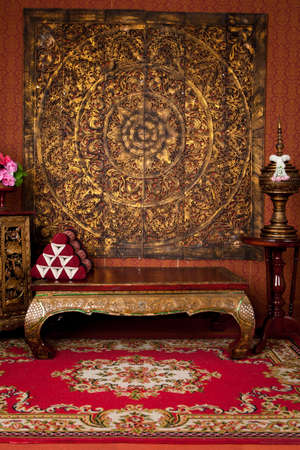Introduction to Traditional Interior Design
Step into any classic American home and youre likely to find yourself surrounded by the warm embrace of traditional interior design. This iconic style, deeply rooted in history, draws inspiration from 18th and 19th-century European decor while adapting seamlessly to American lifestyles. What sets traditional design apart is its sense of order, balance, and refined elegance—think graceful lines, rich wood tones, and furnishings that tell a story. Whether it’s the welcoming presence of a tufted Chesterfield sofa or the dignified charm of a Queen Anne chair, these furniture styles have stood the test of time. Traditional interiors are all about comfort blended with sophistication, making them a perennial favorite across generations. In this article, we’ll explore the roots and key characteristics that have made traditional interior design a timeless staple in American homes.
2. Colonial Influence: American Heritage Furniture
Colonial-inspired furniture forms the backbone of traditional American interior design, combining elegance, practicality, and a touch of Old World charm. Rooted in the early days of the United States, these pieces reflect a blend of English, Dutch, French, and Spanish influences, resulting in a style that is both familiar and steeped in history. The hallmark of Colonial furniture is its focus on craftsmanship—think hand-carved wood details, sturdy frames, and subtle ornamentation that never feels ostentatious. These pieces are typically crafted from native woods such as maple, cherry, or oak, lending warmth and authenticity to any space.
Key Features of Colonial-Inspired Furniture
| Characteristic | Description |
|---|---|
| Material | Solid wood (maple, cherry, oak) |
| Finish | Naturally stained or painted in muted tones |
| Design Elements | Turned legs, spindle backs, and simple carvings |
| Functionality | Multi-purpose with storage features like drawers or hidden compartments |
The Enduring Appeal in Modern Homes
Today’s homeowners appreciate Colonial-style furniture for its timelessness and versatility. Whether it’s a Windsor chair at the dining table or a Chippendale-inspired sideboard anchoring the entryway, these pieces bring an air of nostalgia and comfort. They work beautifully alongside other traditional elements such as patterned rugs or classic drapery, yet can be easily integrated with more contemporary accents for a transitional look.
Tips for Decorating with Colonial Pieces
- Mix Colonial items with modern accessories to keep the vibe fresh.
- Highlight craftsmanship by placing furniture where details can be appreciated up close.
- Select heritage-inspired textiles—think ticking stripes or floral chintz—to complement wooden finishes.
Embracing Colonial influence in your home décor not only pays homage to America’s roots but also ensures your interiors remain welcoming and effortlessly stylish for generations to come.
![]()
3. Victorian Elegance: Ornate Details and Plush Comfort
Step into the world of Victorian elegance, where opulence and sophistication set the tone for traditional American interiors. Rooted in the late 19th century, Victorian furniture is instantly recognizable by its intricate carvings, sweeping curves, and lavish ornamentation. Think deep-buttoned tufting on sofas, rolled arms, cabriole legs, and luxurious upholstery fabrics like velvet or brocade that invite you to sink right in.
Rich Materials and Finishes
Victorian-era pieces often feature dark woods—mahogany, walnut, or rosewood—polished to a high sheen, creating a dramatic backdrop for ornate brass accents or hand-painted details. Marble tabletops and gilded mirrors elevate the sense of grandeur, making every piece feel like a work of art.
Signature Furniture Pieces
No traditional living room inspired by this era would be complete without an overstuffed fainting couch or a gracefully curved armchair. Intricately carved sideboards and display cabinets showcase fine china and collectibles, while four-poster beds draped in heavy fabric transform bedrooms into regal retreats.
How to Incorporate Victorian Style Today
For today’s American homes looking to embrace traditional design with a Victorian twist, balance is key. Pair ornate statement pieces with more streamlined décor to avoid overwhelming your space. Accent a classic Chesterfield sofa with rich throw pillows, or add a vintage-inspired armchair to your reading nook. The goal is plush comfort layered with history—a look that feels both timeless and inviting.
4. French Provincial: Rustic Meets Refined
If you’re searching for a furniture style that gracefully bridges the gap between countryside comfort and regal sophistication, French Provincial is your go-to inspiration. Rooted in the rural regions of 18th-century France—think Provence and Normandy—this style brings together the best of rustic warmth and polished elegance, making it a standout in traditional American interiors.
Softening Spaces with Curves and Lightness
One of the hallmarks of French Provincial furniture is its use of curvy silhouettes. From cabriole legs to gently arched chair backs, these shapes add an inviting softness to any room. Unlike heavy, straight-lined pieces found in some traditional designs, French Provincial’s feminine curves create a sense of movement and grace that lightens up formal spaces.
Signature Elements of French Provincial Furniture
| Feature | Description |
|---|---|
| Curved Lines | Graceful arms, scalloped aprons, and cabriole legs |
| Light Finishes | Distressed white, creamy hues, pastel blues and greens |
| Natural Materials | Solid woods like oak or cherry, often with visible grain |
| Ornate Details | Hand-carved flourishes, floral motifs, and caning |
| Old-World Charm | Subtle patinas and antique-inspired hardware |
The Allure for Modern Traditionalists
French Provincial remains beloved in American homes because it’s both approachable and elegant. The palette is typically soft—think whites washed with hints of gray or muted pastels—which helps brighten rooms while keeping them grounded. Pieces are often distressed to suggest age and history, giving your home instant character without feeling stuffy or overly formal.
How to Use It in Your Home
If you want to introduce French Provincial style into your own space, start with one or two statement pieces—a carved sideboard, a cane-back dining chair, or a light-finished coffee table. Mix these with classic American elements for a look that’s timeless but never dull. In essence, French Provincial furniture offers a romantic nod to the past while fitting right in with today’s love for comfort and charm.
5. Classic American: Shaker and Federal Styles
When it comes to traditional interior design in the United States, few furniture styles are as iconic—or as deeply rooted in American history—as Shaker and Federal. These styles capture the essence of early American life, where practicality met elegant restraint, resulting in pieces that remain timeless even today.
The Shaker Style: Simplicity Meets Craftsmanship
Shaker furniture is celebrated for its minimalism and honest construction. Created by the religious Shaker communities of the 18th and 19th centuries, these pieces favor utility over ornamentation, featuring clean lines, tapered legs, ladder-back chairs, and subtle wooden pegs. The focus is on function, durability, and quality craftsmanship—values that resonate with those who appreciate a “less is more” approach. In modern traditional interiors, Shaker pieces blend seamlessly with other classic styles while maintaining their humble charm.
The Federal Style: Refined Elegance with Patriotic Roots
In contrast to the simplicity of Shaker design, the Federal style—popular from roughly 1780 to 1830—embraces refined details inspired by neoclassical motifs. Think delicate inlays, slender proportions, fluted legs, and decorative elements like eagle or urn motifs. The Federal style reflects America’s early aspirations as a new nation, drawing on European influences but adding uniquely American flourishes. Furniture from this era often features rich woods like mahogany and cherry, making them prized heirlooms in traditional homes.
Why These Styles Endure
Both Shaker and Federal furniture represent more than just aesthetic choices—they’re a testament to American ingenuity and resourcefulness. Their enduring popularity lies in their ability to balance beauty with usability. Whether you’re drawn to the understated grace of a Shaker rocking chair or the sophisticated silhouette of a Federal sideboard, these styles offer a tangible link to America’s past while feeling perfectly at home in today’s traditional interiors.
6. Mixing and Matching: Creating a Collected-Over-Time Look
One of the most charming aspects of traditional interior design is its ability to feel timeless, curated, and deeply personal. To achieve this, blending furniture styles is essential. Rather than sticking strictly to one era or matching every piece, successful traditional spaces often look as if they’ve been assembled over decades—a testament to family history, travel, and evolving taste. Here’s how to master the art of mixing and matching while keeping your home inviting and authentically American.
Start with a Classic Foundation
Begin with foundational pieces like a Chesterfield sofa or Queen Anne chairs—these are anchor items that set a traditional tone. Their recognizable silhouettes and details provide a visual link between different styles and periods.
Add Accent Pieces from Different Eras
Layer in accent tables, cabinets, or lighting from other classic styles such as Federal, Colonial, or Victorian. Don’t shy away from using a Mid-Century credenza or an Arts and Crafts side table; when thoughtfully placed, these pieces add character and prevent the room from feeling like a museum.
Keep Color and Finish Cohesive
To avoid visual chaos, choose a unifying color palette—think rich woods, deep blues, or soft creams. If your furnishings vary in finish, consider re-staining or painting certain items so tones harmonize without being too matchy-matchy.
Use Textiles for Unity
Pillows, drapes, and rugs in classic patterns like florals, damasks, or stripes can tie disparate pieces together. American homes often feature layered textiles for warmth and comfort—don’t be afraid to mix patterns as long as colors complement each other.
Personal Touches Make It Yours
Display collections—be it antique books, blue-and-white ceramics, or vintage Americana finds—to infuse your story into the space. Family heirlooms or flea market treasures make the room feel collected rather than decorated.
Edit and Balance
The key to mixing styles successfully is editing: give each piece room to breathe so nothing feels crowded. Balance ornate with simple—pair an intricate bombe chest with streamlined wingback chairs. This keeps the look fresh while honoring tradition.
By blending furniture styles thoughtfully, you’ll create a welcoming traditional space that’s not just beautiful but also reflects your personal journey—a true American original.


